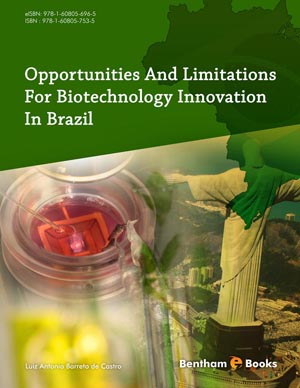Biotechnology and its Applications in Brazil
Page: 3-28 (26)
Author: Luiz A.B. de Castro
DOI: 10.2174/9781608056965113010005
PDF Price: $15
Abstract
The Biotechnology Industry in Brazil is of the size of some State sectors in the US. The one that is closest to the size of the Biotechnology in Brazil is Georgia. Eighty five% of the Biotechnology companies in Brazil have up to fifty employees and revenues of slightly above 1 million US $ /annually. Eighty% of these companies are located in three states: São Paulo, Minas Gerais and Rio de Janeiro (Br Biotech 2011). The academic Biotechnology sector in Brazil is however relevant. Forty eighty Graduate Courses are recognized by the Agency specialized to deal with Education in Brazil: CAPESCoordenação de Aperfeiçoamento de Pessoal de Nivel Superior (CAPES 2013).
Biopharmaceuticals from Brazil
Page: 29-66 (38)
Author: Luiz A.B. de Castro
DOI: 10.2174/9781608056965113010006
PDF Price: $15
Abstract
Biopharmaceuticals are mainly: recombinant proteins, monoclonal antibodies, products derived from nucleic acids and products derived from cells and tissues. The first product was humulin, released 28 years ago. There are 200 biopharmaceuticals approved for use in humans, and all but 2 are proteins. The global market value is close to 100 billion dollars, but there are 2000 products in development process which have not been released yet. As only 0.1% of the products released for human uses are derived from secondary metabolism metabolites, we may clearly notice that even among the 2000 products under development, only a small fraction belongs to the secondary metabolism group. Actually, the biotech pipelines overwhelmed by proteins. The Brazilian Biodiversity (Fig. 1) reserves this space among the biopharmaceuticals to toxins and poisons from reptiles, amphibians and insects, besides various microorganisms and substances from the marine biome. The following analysis, though, describes important adjustments, which are necessary, regarding the laws that regulate access to biodiversity and the patent law.
Partnering to Build Biotechnology
Page: 67-108 (42)
Author: Luiz A.B. de Castro
DOI: 10.2174/9781608056965113010007
PDF Price: $15
Abstract
The strategies to be described in this Chapter emphasizes the importance of partnerships to build Biotechnology in Brazil. Partnerships include bringing together pharmaceutical companies funded with national capital with companies funded with international capital. These partnerships are absolutely essential. Describes in addition how networks can reduce the unbalance we exercise in Brazil, such that 85% of the Continent has only 35% of the science and technology critical mass and as expected only 30% of the National Growth Product. It considers amongst the partnerships in the pharmaceutical area how important is to internalize instruments and institutions such CMOs, CROs and cGMP, not existing in Brazil. It offers equally the possibility for Brazil to play a role in the Gene Revolution, not played before in the Green Revolution especially in agriculture. If successfully applied, the powerful science-based technology we have in our hands will contribute to extend the benefits of the Gene Revolution to the poorest countries; very much as the Green Revolution did in the past reducing the hunger syndrome which claimed the lives of millions of people in some Asian countries decades ago. Norman Borlaug, during a visit to Brazil in February 2004, stated that the 21st century revolution will come from Brazil in the area of agriculture. He further indicated that reducing hunger is essential for the world to achieve socio economic stability, in full agreement with the context of this paper. The FAO Annual Report (FAO 2004) listed the barriers preventing the Gene Revolution from reaching the poor countries: inadequate regulatory procedures, intellectual property rights (IPR) and biosafety, poorly functioning seed-delivering systems and weak domestic plant breeding capacity, all of which are discussed in this paper.
Concluding Remarks
Page: 109-110 (2)
Author: Luiz A.B. de Castro
DOI: 10.2174/9781608056965113010008
Introduction
Brazil has emerged as a significant financial and industrial power in recent times. Brazil is poised to become a significant player in the field of biotechnology, internationally, by taking advantage of circumstances not available in other countries, particularly its native biodiversity. This will, in turn, have an effect on commercial and entrepreneurial opportunities in the region. Topics covered in this text include adjustments that must be made in the regulatory framework to assure the success of business investment. This investment is crucial for training R&D scientists and developing new technologies. The book also covers a debate on transgenic plants which had political ramifications in the region and slowed the adoption rate of genetically modified organisms by almost a decade. The opportunities for commercialization of recombinant DNA technologies in the country are also presented. Opportunities and Limitations For Biotechnology Innovation In Brazil presents a concise overview of the biotechnology industry in Brazil and will be of great interest to a wide range of readers including researchers, biotechnology graduates, as well as both local and international investors.






















